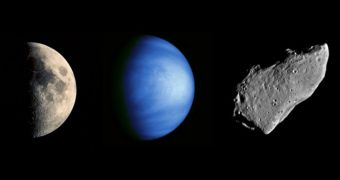Recently, the American space agency concluded one of its contests, which sought to bring in new ideas for projects related to space exploration. Three of these ideas are now selected as finalists, with the final decision scheduled to be taken soon. One of the potential missions proposes a scientific trip to the Moon, the second one sees Venus as an interesting target, while the third showcases the scientific potential of a near-Earth object (NEO). According to NASA, the final decision on which of the projects will get the go-ahead will be taken in 2011, experts at the Jet Propulsion Laboratory (JPL) say.
All of the prospective missions have the potential to provide experts with a better understanding of our solar system, as well as with new knowledge on how life may have evolved on our planet. Additionally, they could also gain new insight into how the Earth itself formed from the protoplanetary disk that surrounded the newly born Sun. All these questions make a lot of sense in light of the new proposals, which state that both the oceans and the Earth's atmosphere are extraterrestrial in origin. As for the new projects, a final decision will be made after detailed mission-concept studies are carried out.
One of the selected projects is to be conducted by researchers at the University of Colorado in Boulder (UCB), led by expert and principal investigator Larry Esposito. The spacecraft would be managed by experts at JPL, and would be called Surface and Atmosphere Geochemical Explorer, or SAGE. It would be aimed at Venus, and its main goal would be to conduct extensive measurements and other studies of the planet's atmosphere and its composition. It could also collect a wealth of meteorological data. The mission is not an orbiter, but a lander, similar to Phoenix on the surface of Mars.
The second mission is known as Osiris-Rex, which stands for Origins Spectral Interpretation Resource Identification Security Regolith Explorer. It is a mission envisioned for a rendezvous with a primitive asteroid, one of the first rocks to form in the vicinity of the Sun, when the star was very young. It is a sample-return mission, which means that, after it orbits the space rock, it could descend on its surface, collect up to two ounces of material, and return them to Earth for analysis. The principal investigator would be University of Arizona in Tucson expert Michael Drake, and the mission would be managed by experts at the Goddard Space Flight Center, in Greenbelt, Maryland.
The third finalist is also a sample-return mission, but this time to the Moon. The MoonRise: Lunar South Pole-Aitken Basin Sample Return Mission envisions landing a spacecraft at the south pole of the Earth's natural satellite, in a broad basin. According to early plans, the spacecraft would be capable of collecting up to two pounds of material, and return them back home for analysis. The basin is special because experts believe it's made of rocks that were churned from the Moon's mantle. Washington University in St. Louis (WUSL) expert Bradley Jolliff would be the principal investigator, and the project would be managed by scientists at the JPL.
“These are projects that inspire and excite young scientists, engineers and the public. These three proposals provide the best science value among eight submitted to NASA this year,” Ed Weiler says. He is the NASA Science Mission Directorate associate administrator, at the space agency's headquarters, in Washington, DC.

 14 DAY TRIAL //
14 DAY TRIAL //